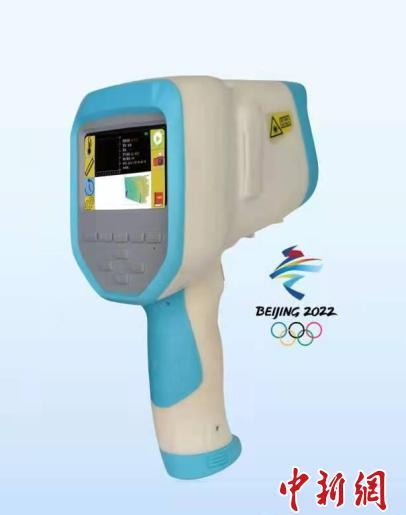
Snow temperature snow-like observer Courtesy of 23 Institutes of the Second Academy of China Aerospace Science and Industry Group
Beijing, February 3 (Xinhua) -- In more than 1 minute, the snow status of the snow on the snow project track was identified, and the wind field observation data of thousands of meters above the observation point was automatically given in 6 minutes...
In order to provide a good meteorological data service guarantee for the Beijing Winter Olympic Games, the Aerospace New Meteorological Company affiliated to the 23 institutes of the Second Academy of China Aerospace Science and Industry Group provides meteorological radar, automatic weather stations, snow temperature snow-like observers and other multi-type meteorological products for the three major competition areas, multi-dimensional "pulse" weather, obtain meteorological element information of different heights, different ranges and different categories, and provide services for the construction of the meteorological forecast monitoring network of the Winter Olympics with minute-level and gridded meteorological data.
The main venues for the snow sports of the Beijing Winter Olympics are in Yanqing and Zhangjiakou. Compared with the ice competition venues, the snow competition venues are mostly in the mountainous areas with harsh natural conditions and complex terrain, and three-dimensional and multi-dimensional weather forecasts are more necessary.
Millimeter wave cloud measurement radar Courtesy of 23 Institute of the Second Academy of China Aerospace Science and Industry Group
Since 2014, dozens of sets of meteorological equipment such as wind profile radar, cloud measurement radar and automatic weather station have been successively deployed in Yanqing and Zhangjiakou Racing Areas and near Haituo Mountain, from ground observation to vertical observation, providing grid meteorological data services with different heights and different elements for the event.
The millimeter-wave cloud measurement radar located at the top of Haituo Mountain is an effective equipment for the realization of cloud fine detection, accumulating snowfall observation data for the Winter Olympics for six consecutive years. Through continuous automated observation of clouds, it analyzes the water content, spatial position, and movement speed of clouds, helps to carry out comprehensive detection and analysis of weather processes such as clouds, rain, and snow, and monitors low-visibility weather such as low clouds, snowfall, and fog in real time, provides early warning, and provides effective data for artificially influencing weather.
As the main equipment of the scientific expedition, the cloud measurement radar has climbed to the top of the world and participated in the 2015 Qinghai-Tibet Plateau scientific expedition test. Since 2017, it has squatted on Haituo Mountain to carry out snow measurement tests and continue to reserve data for the meteorological support of the Winter Olympics.
Automatic weather station 23 Institutes of the Second Academy of China Aerospace Science and Industry Group Courtesy of the map
For projects such as aerial skills and platform jumping, a detailed forecast of the wind is crucial. Wind profile radar can provide a set of real-time wind field data for the competition area every 6 minutes with high temporal and spatial resolution, and detect wind field changes in real time, such as in alpine skiing areas, wind profile radar detection data can be used to calculate the direction and intensity of longitudinal and crosswinds between the slopes. In the three major competition areas of the Winter Olympic Games, there are wind profile radars to provide data services.
Wind profile radar has provided meteorological support for the 2008 Olympic Games Qingdao Regatta. It is widely adapted to a variety of local environmental monitoring, providing users with high-precision meteorological services, in line with the use of urban short-term weather forecasts, in many domestic civil aviation airports and meteorological stations, can see its figure.
Among the ground meteorological equipment, the radar observation range is wide. However, for alpine skiing, a sport with a schedule of only 1 to 2 minutes, meteorological data needs to be more refined, and automatic weather stations take on the responsibility of small-scale, multi-element fine meteorological observation.
Wind profile radar Courtesy of 23 Institutes of the Second Academy of China Aerospace Science and Industry Group
At the National Alpine Ski Center, automatic weather stations stand like "small light poles" with their own suitcases at the top of the track and on the mountainside, wind direction, wind speed, temperature, humidity, snow depth... Each meteorological data that affects the competition status of the athletes on the side is collected and transmitted in real time, and this information is integrated with the conventional meteorological data of radar and other equipment to help simulate weather changes here and there in the future and provide a basis for meteorological forecasts.
In addition, in order to better observe the state of the snow surface on the track, the snow temperature snow observation instrument has become the smallest contact point of the meteorological detection grid, and this handheld portable product specially customized for the Winter Olympics can automatically identify the status of the snow and transmit the observations to the command department in real time, which is the "just needed product" for the encrypted observation of the snow surface temperature of the track.
From the ground foundation to the air foundation, from a small point to a large area, meteorological equipment with different detection ranges and elements has woven a strict meteorological detection network, providing "dense" data services for meteorological observations of the Beijing Winter Olympics. (End)